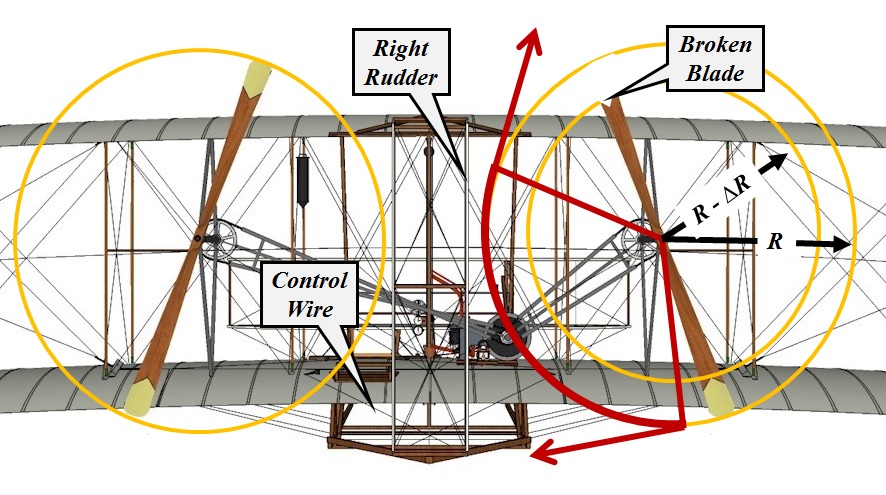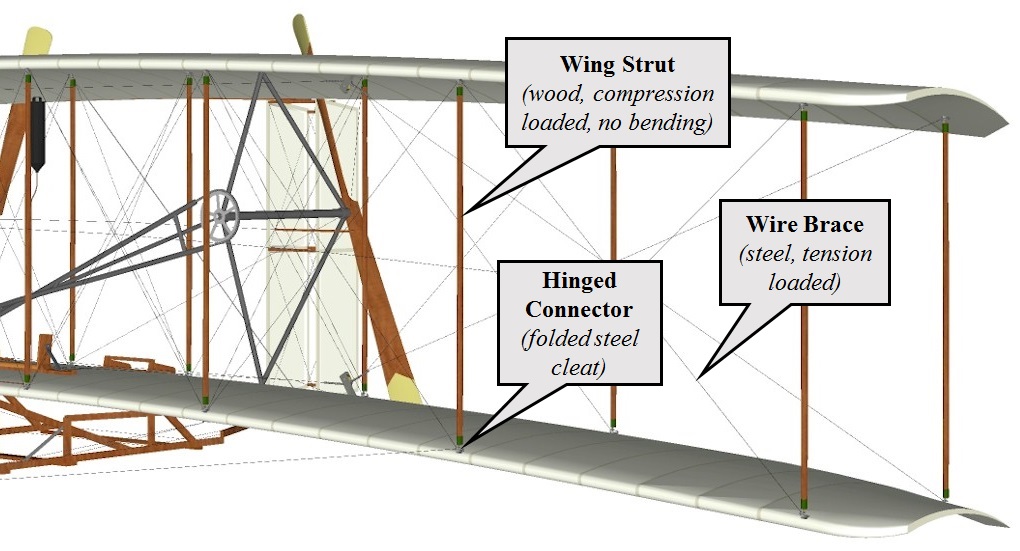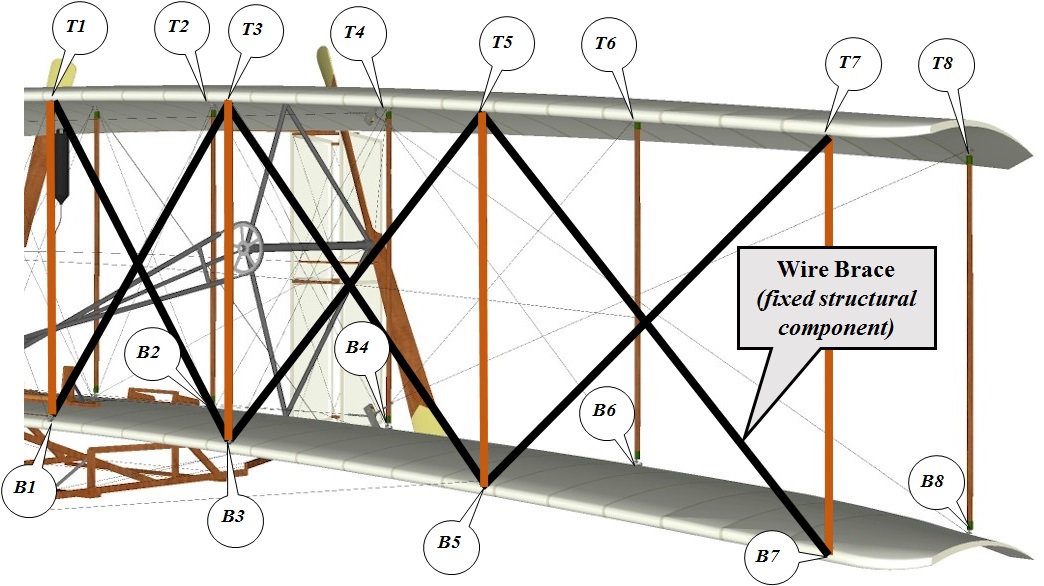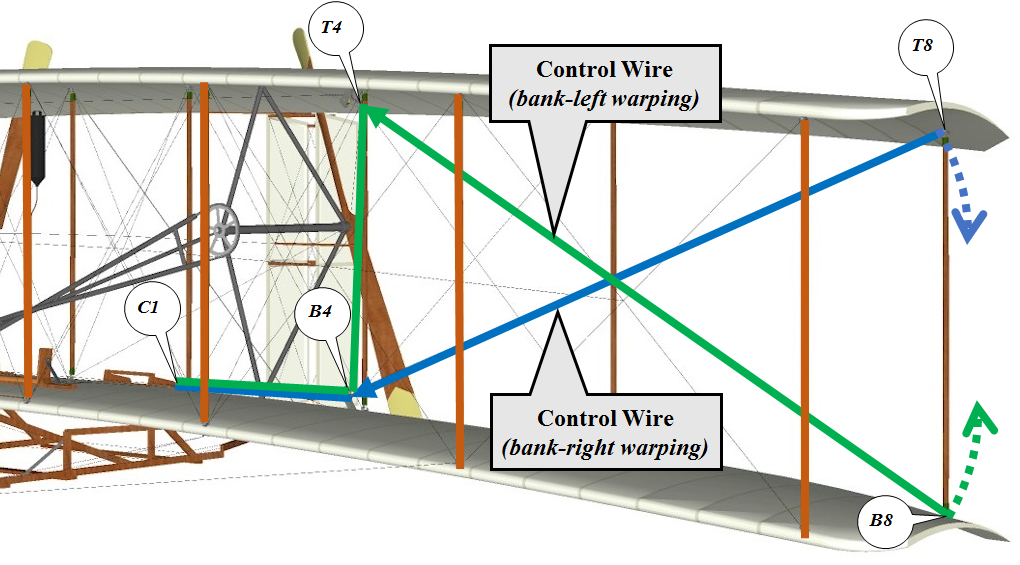|
Version 2.1 Copyright ©2017 by Paul Niquette. All rights reserved. |
|||||||||||||||
The machine suddenly turned to the right and I immediately shut off the power. Quick as a flash, the machine turned down in front and started straight for the ground. Our course for 50 feet was within a very few degrees of the perpendicular.The puzzle formulation describes how, during a demonstration flight in 1908 at Ft. Myer, Virginia, part of the right propeller of the Wright Flyer Model A broke off in flight at 150 feet elevation. The result was a fatal crash, and we have been asked... What is your
explanation for the sudden turn to the right with
power on,
followed by pitching straight down with power off? Moreover, the analysis so far has concluded that the blade fragment did not strike the rudders and could not have damaged the aft part of the aircraft structure enough to explain the events described by Orville Wright. If so, the blade fragment itself "did not play a rôle in the rest of the drama." However, we shall see that the absence of the blade fragment was a significant causal factor in bringing down the Wright Flyer on September 17, 1908.
Immediately after the separation of the blade fragment, the engine thrust would be reduced. That means airspeed would necessarily begin decreasing limited by inertia, causing gradual loss of lift on the wings. More importantly, the aircraft was instantly subjected to 'asymmetrical thrust'. Here is a curve that estimates the differential thrust between the two propellers as a function of the length of the blade break. It is derived from First Principles, which mathematically integrate local increments of blade thrust from the hub to the break at R - ∆R, recognizing aerodynamic 'lift' according as the square of tangential velocity. For example, a break at ∆R = 24 inches would reduce the thrust from the right propeller by 20% of thrust from the undamaged left propeller (referenced to total thrust). About half of that, 10%, was the impact on overall thrust. Resistance to rotation of the propeller is inversely proportional to the pro-rated lift-to-drag ratio of the blade. That means the engine increased its speed after the blade break, which partially offsets the loss in total thrust following separation of the blade fragment.It is important to note that the yaw force developed instantaneous as the fragment broke away. Orville Wright's perception was that the machine suddenly turned to the right. However, inertia meant that some time elapsed during which the actual turn would have gradually begun. From that point on, aerodynamics participated in the final sequence of events. To understand those aerodynamic events and to explain them, solvers are hereby offered a review of certain features designed into the Wright Flyer, beginning with this excerpted view of the left wing.
There are eight wooden struts and 24 steel wires between the wings on each side of the aeroplane. All but two of the wires are fixed, structural braces. The best strength-to-weight ratio for steel is in mechanical tension. Each strut acts in compression without bending forces, thanks to the hinged connectors at each end. For understanding descriptions to follow, the next sketch labels stationing of the structural elements and emphasizes the struts and wires along the leading edge of the left wing.
Wing warping was an innovation begun earlier in the development of Wright Gliders, and it was proven successful in achieving 'lateral stability' for the whole flying enterprise. Today the expression "pilot control of roll" would be more appropriate, and controlling roll is -- well, it is the rôle of aelerons. How roll or 'banking' was accomplished in the Wright Flyers is illuminated in the next two sketches...
Under normal circumstances the Wright Flyer, would be commanded to roll into a right turn by pulling taut the indicated bank-right warping control wire. That causes the left tips of both wings to be warped downward, increasing their angle-of-attack and thus increasing lift on the left. Conversely a left turn would be commanded by pulling taut the bank-left warping control wire, which causes the left tips of both wings to be warped upward, decreasing their angle-of-attack and thus decreasing lift on the left.
Continuing with the description of wing warping under normal circumstances, we observe that pulling taut the bank-right warping control wires on both left and right must simultaneously slacken the bank-left warping control wires on both left and right. Those control requirements were fulfilled in the cockpit at C1. Returning to the final seconds of the fatal crash as narrated in Orville Wright's letter, let us retrospectively organize those frantic aerodynamic events into four phases... Phase 1: Yawing to the Right, Flat Skid with Engine Power and Asymmetrical Thrust We have noted that the asymmetrical thrust began instantly as a yaw force. Although the pilot felt that force and apparently interpreted it to mean that the machine suddenly turned to the right, angular inertia meant that an actual turn would have taken some seconds to develop. Indeed, during that interval the plane would start yawing to the right in a flat skid more than a turn, the latter characterized by actually changing flight course to the right. Orville Wright's letter to his brother Wilbur makes no mention of uncommanded rolling or banking. Despite the passage that reports the machine suddenly turned to the right, we must surmise that Orville Wright's initial experience was that of a level skid, with the asymmetrical thrust suddenly yawing the aircraft to the right. In a skid, the airflow over the full length of both wings would not have been orthogonal to the wingspan, thus diminishing lift on both sides. At the same time, there was an increase in parasite drag as longitudinal structures are being held at an angle to the relative wind. These effects would mean loss of airspeed during Phase 1. Blown laterally by the relative wind in the skid, the rudders would tend to be weathercocked leftward as if operated by the pilot for yawing to the right. Phase 2: Rolling to the Right with Engine Power and Asymmetrical Thrust With or without wing-warping by the pilot, as the aeroplane began yawing to the right, the wings top and bottom began moving through the air faster on the left than on the right, inasmuch as the wing on the left had farther to travel than the wing on the right in equal elapsed time intervals. The machine began banking toward the right with a gradually increasing roll-rate as limited by inertia. With years of self-taught 'flight skills' in Wright Flyers, Orville Wright's reflexes were well developed for balancing out spontaneous changes in flight attitude. His letter says that he immediately shut off the power. However, we must presume that without even thinking about it, he immediately began operating the controls to resist the uncommanded yawing and rolling of the Wright Flyer before he shut off the power. We can reasonably surmise what Orville Wright's actions were in Phase 2 and their effects. Even if we assume he had time to position the steering controls all the way toward the left, it was most unlikely that the warping of the wings and the deflection of the rudder would have been effective in completely overcoming the uncommanded turn to the right against the asymmetrical thrust imposed by the engine power? If we take Orville Wright at his word -- that he immediately shut off the power -- the durations of both Phase 1 and Phase 2 were extremely brief, offering insufficient time for the aircraft attitude to change beyond the mere perception that the machine suddenly turned to the right. Phase 3: Yawing to the Left with Engine Power Shutting Down When Orville Wright immediately shut off the power, the aircraft's single engine rapidly changed from power-on to power-off. With no ability to feather the propellers, the thrust changed abruptly to engine drag resulting from the windmilling of both propellers against the 'pumping' torques within the engine. Thanks to the shortened blade on the right, the engine drag on the left would have been stronger, yawing the aeroplane to the left. Presumably still in near-level flight, the Wright Flyer was already decelerating in Phase 2, and with the propeller drag, deceleration would have suddenly increased beyond what was generally experienced in Wright Gliders. As an experienced glider pilot, though, Orville Wright instinctively shoved forward on the elevator control to avoid a stall. Though not explicitly included in his narrative, that action is commensurate with his description -- quick as a flash, the machine turned down in front. With the right propeller blade shortened, the engine drag was asymmetrical -- not unlike the asymmetrical thrust in Phase 2, but producing a yaw force in the opposite direction. Depending on how quickly the engine power was shut down, the Wright Flyer would begin yawing toward the left. At that instant, Orville Wright would still be positioning the steering control toward the left as described in Phase 2. Both wing-warping and rudder deflection would then be acting to produce a coordinated turn at that moment to the left. The aeroplane was then inadvertently assisted by asymmetrical engine drag in the pilot's struggle to recover from the turn to the right. Phase 4: Wings Level, Pitching Downward with Both Propellers Windmilling Airspeed had begun declining sharply during Phase 3, resulting from propeller drag and aggravated by back and forth wing-warping drag forces, which were brought about by the pilot's efforts to avoid unwanted banking of the aeroplane. With engine power off and both propellers windmilling, the Wright Flyer continued to face ferocious drag forces. Whether a sufficient flying speed could be maintained depended on the angle of descent. Given no more than 150 feet of altitude above ground level at the instant of the blade fracture, the final passages in Orville Wright's letter must be looked at closely. That the aeroplane had started straight for the ground at its highest elevation, though astonishing in retrospect, is certainly explainable as a perception by Orville Wright -- the word straight implying not turning. If so, either the turn to the right in Phase 1 must not have become fully experienced in Phase 2 or the turn must have been stopped by the asymmetrical engine drag in Phase 3. The general expression straight for the ground allows for any angle of descent -- but certainly not immediately perpendicular in the first 100 feet. As in Phase 3, the pilot was continuing his efforts to prevent a stall with forward pitch-control in Phase 4. We need to reconcile that reality with the next passage which describes the course with specificity: for 50 feet was within a very few degrees of the perpendicular. Accordingly, the final two sentences in Orville Wright's letter make more sense if one inserts a two-word phrase... Quick as a flash, the machine turned down in front and started straight for the ground. Lesson
for pilots from the Flyer
Fatality puzzle...
Reference
|




